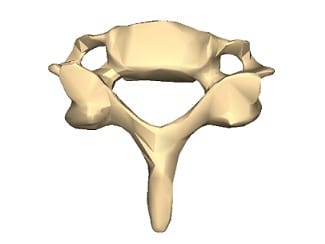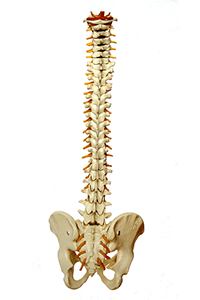 The vertebrae are the short bones that make up the spine . These bone structures are articulated with each other.
The vertebrae are the short bones that make up the spine . These bone structures are articulated with each other.
The intervertebral discs function as a separation between the vertebrae. These are cartilaginous structures that act as ligaments and that, in turn, allow the vertebrae to perform certain movements.
An adult human being has twenty-four vertebrae , while a child has thirty-three vertebrae . This is because, in adulthood, the bones of the coccyx and sacrum join together, fusing four coccygeal vertebrae on one side and five sacral vertebrae on the other.
If we analyze the human spine starting from the bottom, first the coccyx or coccyx appears and then the sacrum . Next we find the five lumbar vertebrae , the twelve thoracic vertebrae and the seven cervical vertebrae , in that order.
It is important to mention that most vertebrae have a similar structure. The exceptions are the first and second cervical vertebrae (the atlas and axis ), whose characteristics are slightly different.
While the cervical vertebrae constitute the neck , the thoracic vertebrae form part of the thorax and have ribs attached to them. Below the last thoracic vertebra and above the sacrum are the lumbar vertebrae.
Among the functions of the vertebrae, it should be noted that these bones allow a person to stand , for example. They also provide protection to the spinal cord . The vertebrae, on the other hand, can suffer from various disorders and conditions such as diseases, trauma, and infections.
As a curious fact, most injuries to the vertebrae occur due to traffic accidents, falls or blows while practicing a sport, and attacks in hand-to-hand fights. This may indicate that in ancient times, long before civilization as we know it today, it is likely that our ancestors did not suffer this type of damage so frequently.
 The spinal cord is a fragile tube-shaped structure that originates where the brain stem ends and extends until it reaches the base of the spine. It is made up of a series of nerves that carry input and output messages that travel between the brain and other parts of the body. As you can imagine, a spinal cord injury has the potential to impact the vertebrae , and also the spinal nerves, whose roots are located between the vertebrae.
The spinal cord is a fragile tube-shaped structure that originates where the brain stem ends and extends until it reaches the base of the spine. It is made up of a series of nerves that carry input and output messages that travel between the brain and other parts of the body. As you can imagine, a spinal cord injury has the potential to impact the vertebrae , and also the spinal nerves, whose roots are located between the vertebrae.
As the vertebral column protects and surrounds the spinal cord, any injury to the first or its connective tissue (whether ligaments or intervertebral discs) also affects the second. Some examples of this indirect damage are the following:
* complete separation (also known as dislocation ) of adjacent vertebrae;
* fractures;
* subluxation (that is, a partial misalignment) of adjacent vertebrae;
* distention of the connecting ligaments, which are made up of connective tissue and are found between adjacent vertebrae;
If a person is suspected of having suffered an injury such as those described above, the doctor should perform diagnostic tests such as an x-ray (usually done immediately after the injury occurs, in the emergency room), a CT scan (separate from x-ray; it offers a higher degree of precision in observing bone injuries) or an MRI (most indicated for damage to the spinal cord and spine). It should be noted that this latter test cannot be performed on patients with devices such as pacemakers.
